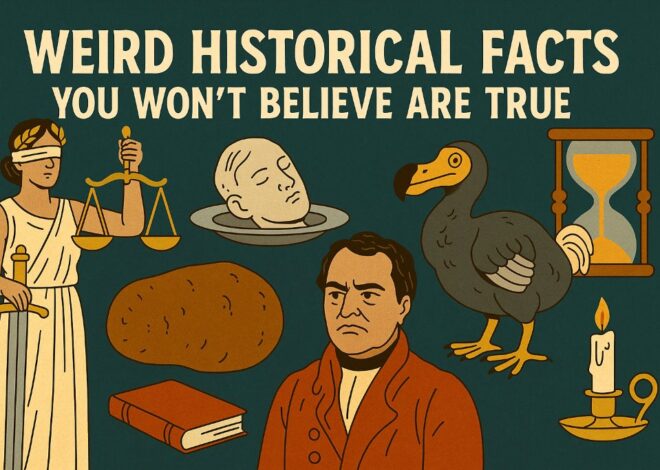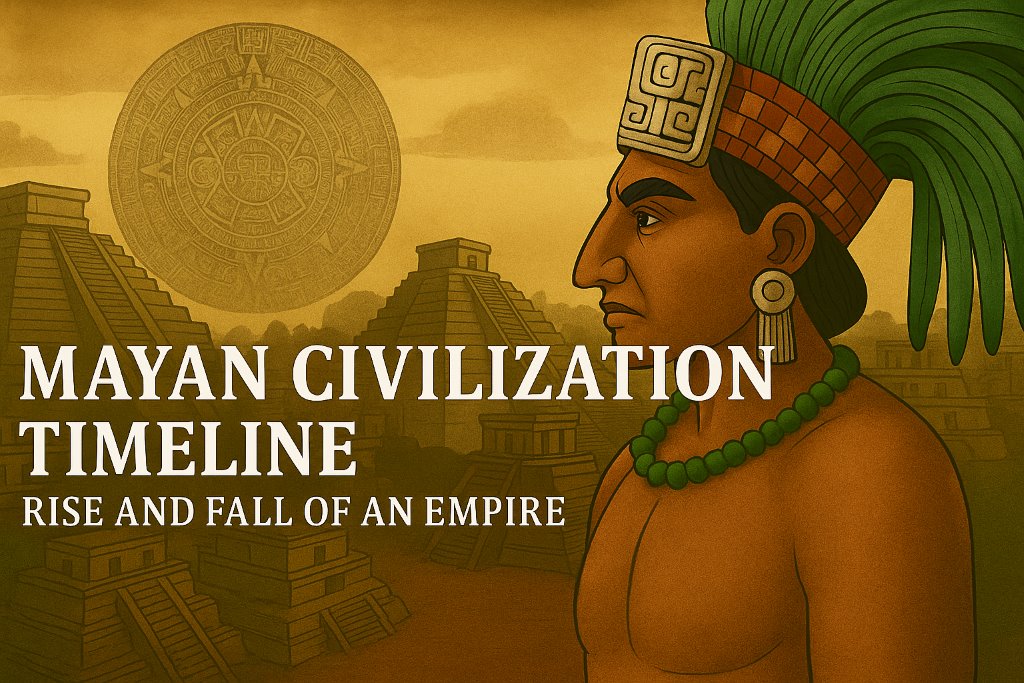
Mayan Civilization Timeline: Rise and Fall of an Empire
Here’s a clear map through a huge past. The Mayan civilization timeline runs from small farming hamlets to stone cities that doubled as calendars, from royal rivalries to quiet survival after courts collapsed. If pyramids and glyphs feel mysterious, that’s fine—we’ll go step by step. Think of this as a grounded Mayan history timeline you can skim for dates or read straight through when you want the longer story.
Early Beginnings (2000 BC – 250 AD)
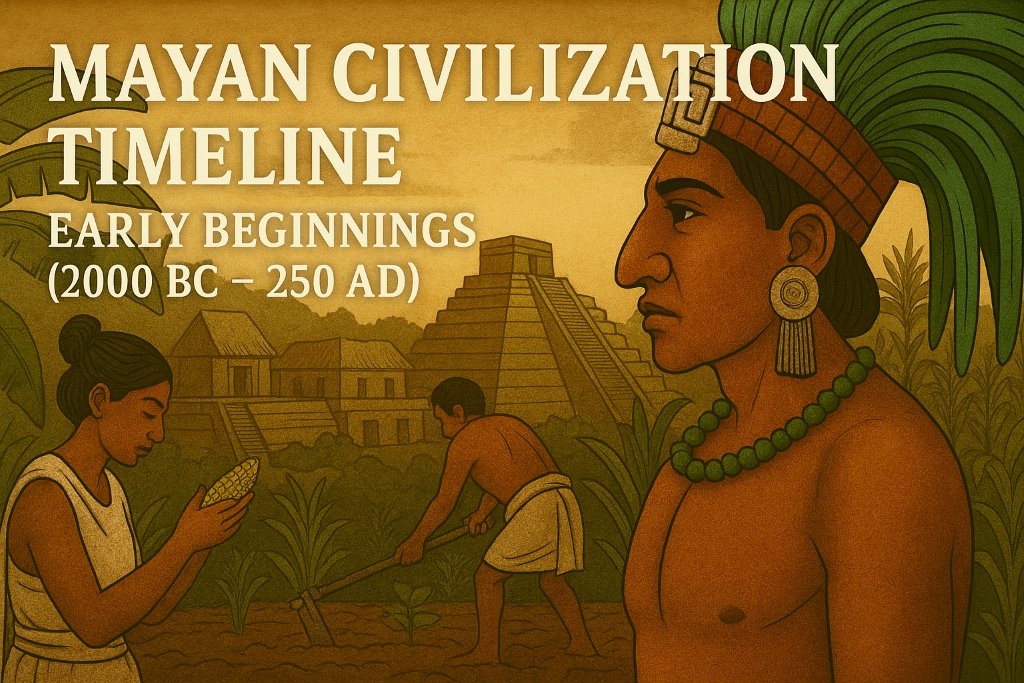
Start with maize, water, and patience. Between 2000 and 1000 BC, families along the Pacific coast and in the lowland jungles shaped fields of maize, beans, and squash. Pottery appears; villages thicken; earthen platforms rise. Early shrines and community plazas suggest leadership by ritual rather than by kings. It’s a quiet revolution – the invention of reliable food and shared space.
Between 1000 and 400 BC, those shared spaces turn monumental. Sites such as El Mirador and Nakbé grow into vast ceremonial centers with wide causeways (sacbeob), plastered plazas, and stucco masks the size of houses. In the highlands, Kaminaljuyú anchors trade between volcanic valleys and the lowlands. The population curve tilts upward; labor is organized; architects start thinking in straight lines and cardinal directions. It’s a quiet revolution – the invention of reliable food and shared space, a turning point that places the Maya firmly among the great ancient civilizations of history.
Late Preclassic (c. 400 BC – 250 AD) is when writing and calendar time flicker into view. Early glyphs appear on stelae and portable objects, and the calendar system—260-day ritual cycle, 365-day solar year, and Long Count—locks into place. These aren’t just scientific curiosities. They schedule planting and festivals, coordinate tribute and labor, and wrap local stories into a shared, repeatable rhythm of time.
By 400–250 AD, the tool kit is complete: masonry temples, corbel vaulting, trained scribes, and dynastic ambition. Trade routes move obsidian, jade, cacao, salt, and shell across mountains and swamps. When the Classic Period begins, the region is ready for big experiments in city life.
The Classic Period (250 – 900 AD)
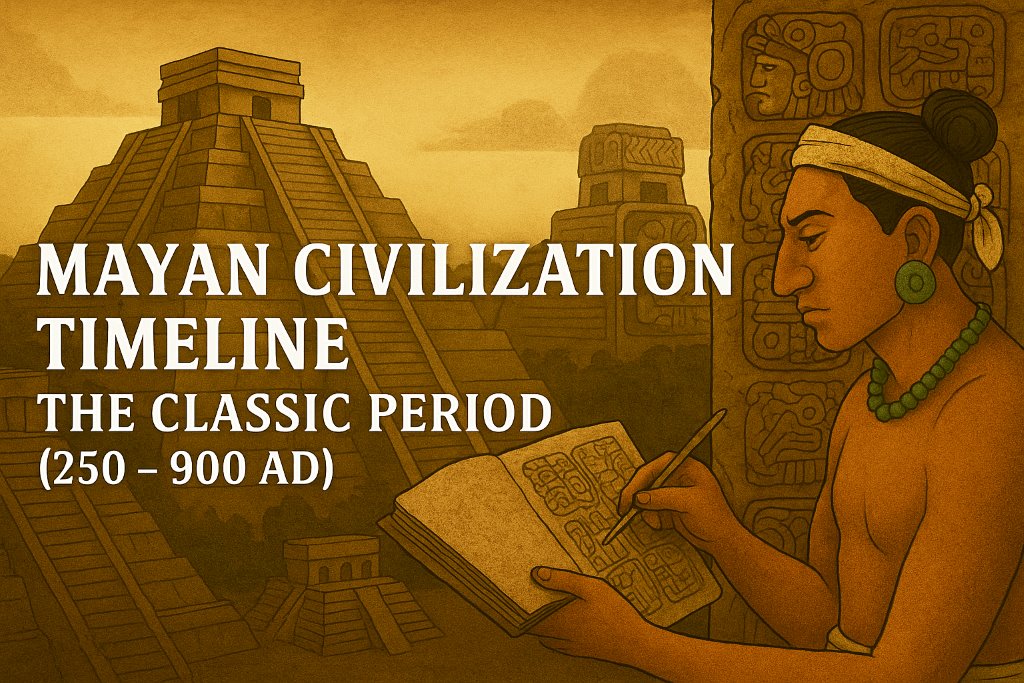
“Empire” is the easy word, but the Classic Maya were a mosaic of kingdoms that spoke related languages and competed like clever neighbors. This is the heart of the mayan empire timeline –not a single throne, but dozens of courts bargaining, marrying, raiding, and boasting on stone.
Early Classic (250–600): networks and narratives
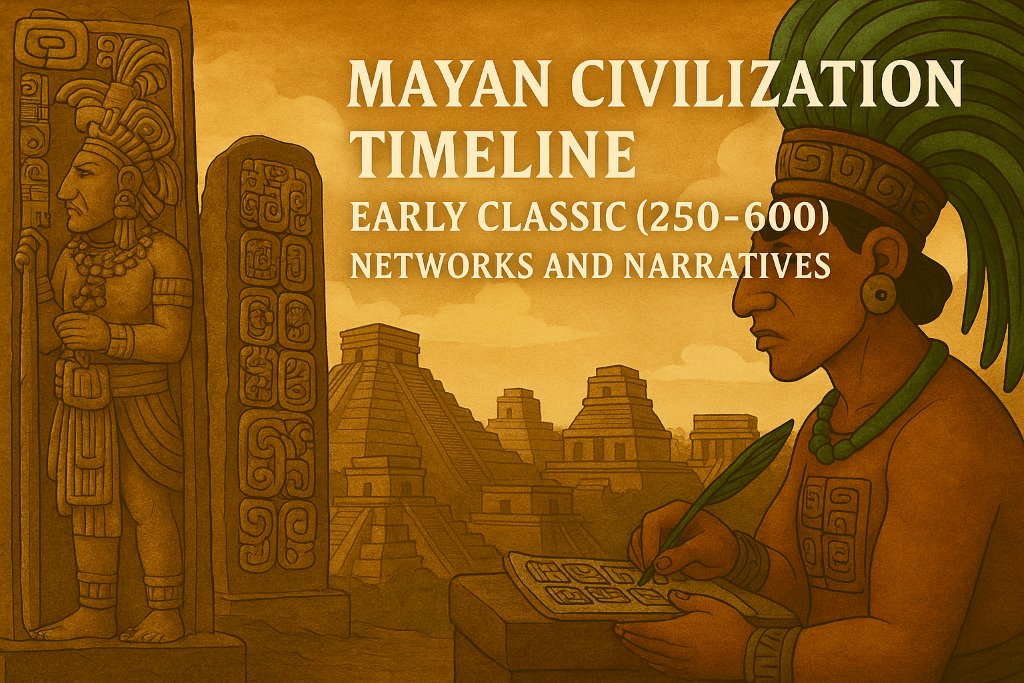
Tikal rises; Calakmul grows into a challenger; Palenque and Copán cultivate distinctive styles. Influence from central Mexico—especially Teotihuacan—shows up in iconography and weapons. Stelae become billboards for royal identities: births, accessions, alliances, and raids. Monumental architecture follows astronomical sightlines: stair counts echo days, temple axes catch solstices, and observatory windows frame Venus at key points in its cycle.
Late Classic (600–750): golden craft, sharper wars
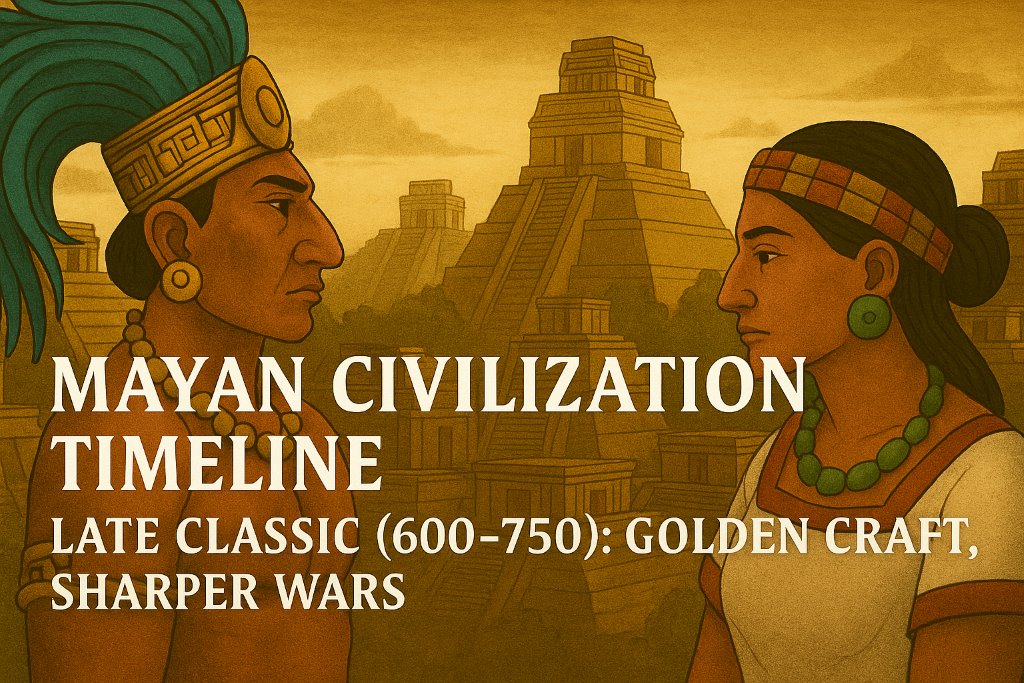
This is the age of refined stucco, elaborate roof combs, and exquisite painted ceramics. Urban populations peak. Agricultural intensification—terracing, raised fields, managed wetlands—keeps food moving into capital markets. Warfare professionalizes: states fight for trade routes, water, and clients. Captives become political currency and ritual actors. Courts hire scribes and sculptors who record victories with confident glyphs that modern epigraphers can now read with surprising detail.
Terminal Classic (750–900): strain and reorganization
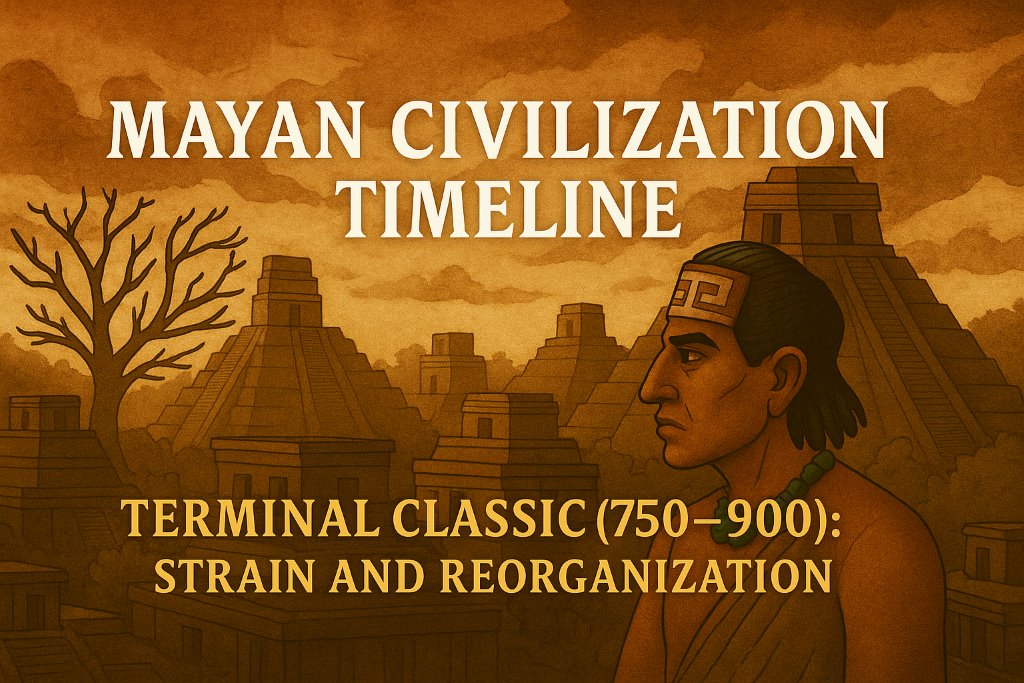
Monument erection slows; some cities pivot into quick, showy building sprees; others fall quiet. Climate data point to episodes of prolonged drought during this window. Add deforestation around urban cores, succession crises, and trade disruptions, and you get a long, uneven unraveling rather than a single “collapse.” Many people relocate—to the coasts, to smaller towns, or to highland strongholds able to operate without the cost of giant ceremonial programs.
The Decline of the Mayan Civilization (900 – 1500 AD)

Decline is real, disappearance isn’t. After 900, the southern lowlands lose many royal courts, but power shifts rather than ends. The Postclassic is faster, more commercial, and politically flexible.
Chichén Itzá and regional exchange
Between roughly 900 and 1100, Chichén Itzá dominates northern Yucatán. Its architecture adds columned halls and market spaces to the classic pyramid silhouette. The great ballcourt amplifies spectacle; the equinox shadow on El Castillo – the feathered serpent rippling down the staircase – folds astronomy into public theater. Coastal ports plug the city into Caribbean trade: cotton, salt, copper bells, feathers, and cacao move through warehouses and along sea routes navigated with knowledge passed from pilot to pilot.
Mayapán and the league of cities
By 1200, Mayapán consolidates political authority behind city walls, forming a league that coordinates multiple lineages and towns. For two centuries the city manages tribute, diplomacy, and ritual. Around the mid-1400s, factional conflicts fracture the league. Power decentralizes to regional polities (including the Xiu and Cocom), which continue to negotiate and fight into the 1500s.
Highland kingdoms and new texts
In the Guatemalan highlands, the K’iche’ and Kaqchikel form capitals such as Q’umarkaj (Utatlán) and Iximché. They produce annals and mythic histories in the early colonial era—the K’iche’ Popol Vuh and the Kaqchikel Annals—that preserve preconquest memory and worldview. These are not footnotes; they’re primary voices that make the late story visible from the inside.
Contact, disease, and conquest
European diseases arrive before armies, cutting sharp, early wounds. When Spaniards finally push into the peninsula and highlands, they meet not ruins but dense political landscapes. Some towns ally, some resist, and many do both in sequence. Conquest takes decades; Spanish authority remains thin in forested zones for generations. Even within missions and colonial towns, Maya languages, rituals, and household economies adapt rather than vanish.
Mayan Achievements and Contributions

Lists are useful; context makes them unforgettable. These are the big achievements – each tied to daily life, not just to monuments.
Calendars and astronomy
The Maya run time like music in multiple meters. The 260-day ritual cycle (Tzolk’in) weaves with the 365-day solar year (Haab’); together they create a 52-year Calendar Round for naming days and planning ceremonies. The Long Count anchors historical events to absolute dates stretching back before 3114 BC in their reckoning. Priests track Venus cycles to advise rulers on war and diplomacy. Architecture cooperates: E-Group complexes and temple sightlines capture sun positions; stair counts encode calendrical math in stone.
Mathematics and zero
The Maya use a vigesimal (base-20) system with a true zero – represented by a shell sign—that allows clean positional notation. That zero appears on monuments centuries before many other regions adopt it formally. Calendrics, tribute, astronomy, and construction all rely on this crisp math; you can watch it at work in bar-and-dot numerals on stelae and stairways.
Writing and literature
The script is logosyllabic—part word signs, part syllables – which means it can record full speech. Elite titles, place names, dates, poems, boasts, and prayers all show up in the glyph bands that wrap vases and march across stone. The decipherment effort of the last century turned “mysterious symbols” into living voices: kings, queens, dwarfs, dancers, scribes, and captives all reentered the story. In the early colonial period, Maya authors wrote on paper instead of stone, producing works such as the Popol Vuh that link myth, history, and ethics.
Engineering and urban design
Without draft animals or metal tools, Maya engineers organized labor to reshape landscapes: they quarried limestone, paved plazas, cut causeways between districts, and built reservoirs and canals to regulate water. In swampy zones, they gardened wetlands into productive raised fields; in hills, they terraced slopes to hold soil. Cities were machines for living and thinking—hydrology here, market there, temple sightlines locked to celestial events—more deliberate than their graceful ruin suggests.
Art and aesthetics
Bonampak’s murals spill music and ceremony across walls; Palenque’s stucco portraits breathe; Copán’s sculptures turn glyphs into bodies and bodies into glyphs. Polychrome vases show courtly banquets and mythic scenes with energy that still reads across time. Jade pendants carry green light; shell mosaics glitter in dim rooms; even household figurines feel alive in the hand. It’s court art, yes, but it’s also a record of etiquette, costume, and mood.
Rediscovery and Archaeology
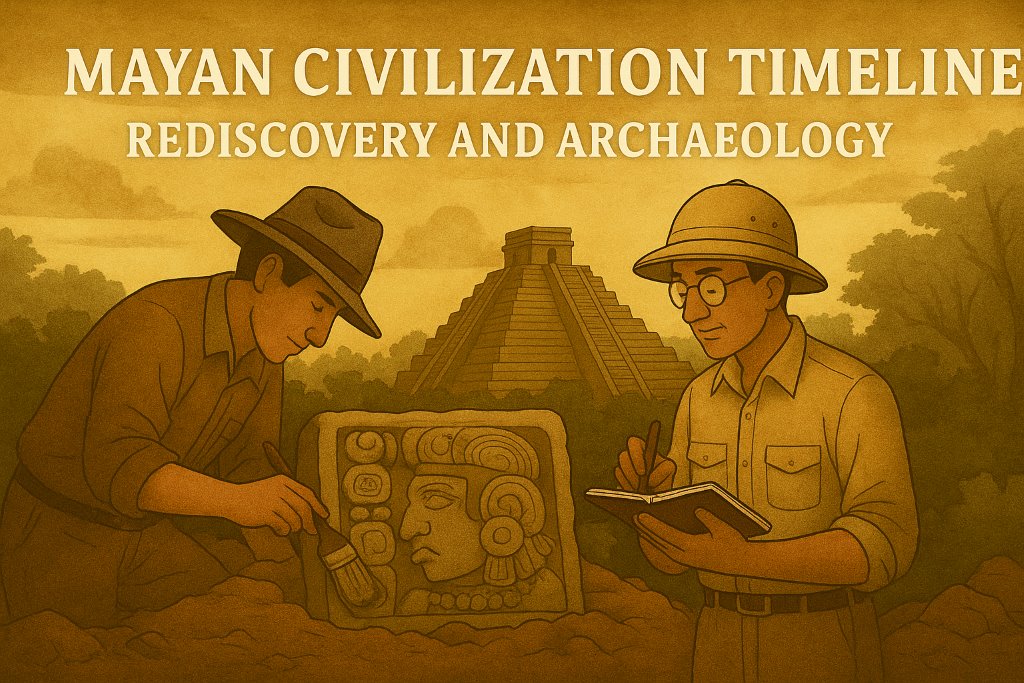
The cities kept standing after courts dissolved; the forest simply overgrew them. In the 19th century, local guides and foreign travelers reported and sketched ruins that shocked audiences abroad. Early work mixed documentation with plunder; later projects shifted toward careful excavation and conservation. Through the 20th century, archaeology grew more scientific—stratigraphy, radiocarbon, ceramic sequencing—and more collaborative with Maya communities who live beside and within these sites.
Decipherment is the behind-the-scenes thriller: Tatiana Proskouriakoff recognized historical patterns in stelae; Yuri Knorosov proved phonetic readings; Linda Schele, David Stuart, and many others expanded the dictionary and grammar. As phonetic values clicked into place, kings and queens stepped out of the “priest” costume assigned to them by earlier scholars. We could finally read birthdays, accession rituals, alliances, defeats, and jokes—yes, jokes—carved in stone.
Technology keeps changing the map. LiDAR—airborne laser scanning—strips away canopy to reveal causeways, defensive walls, household clusters, and agricultural features invisible from the ground. The picture that emerges is not of isolated ceremonial centers, but of complex urban regions with suburbs, roads, and farms tied to civic cores. Paleoclimate studies read lake mud as history books, correlating drought episodes with political stress. Residue analysis identifies cacao and other foods in ancient vessels, linking diet to ritual and trade.
Modern projects emphasize ethics as much as data: site protection, descendant community leadership, fair tourism, and transparent archives. The result is a story that’s both sharper and more human.
Lessons From a Long Arc
What holds after the tour? First, resilience. The Mayan civilization timeline does not end in 900 or 1524; it continues in living languages—Yucatec, K’iche’, Kaqchikel, Mopan, Itza’—and in villages and cities where people farm milpa fields, weave, trade, teach, and vote. Second, fragility. Urban systems crack when climate stress, political overreach, and ecological strain stack together. Third, knowledge matters—especially when it travels. A calendar can coordinate miracles, but it can’t repeal drought; a ledger can build pyramids, but only if forests and neighbors cooperate.
For students building a Mayan history timeline, here’s the short scaffold: Preclassic villages (2000–250) experiment and scale; Classic courts (250–900) build, write, trade, and fight; Postclassic networks (900–1500) reconfigure and commercialize; colonial centuries reorganize power without erasing people. For everyone else, a handful of Mayan civilization facts make the story stick: a true zero, cities aligned to the sky, literature carved in stone, and a civilization that redirected rivers without steel.
Call it a Mayan empire timeline only if you remember that the power was plural. The lesson that travels best is simple and hard: plan for climate noise, distribute risk, keep knowledge public, and design cities that can bend without breaking. The Maya did all of this—just not always at once. That complicated truth is why their story still teaches.
One more piece at the start: neighbors. Early Maya communities interacted with other Mesoamerican traditions—especially the Olmec horizon along the Gulf Coast. Ideas about sacred mountains, jaguar power, and formal ballcourts moved through exchange networks. The Maya adapted that shared toolkit to local landscapes, then added their own inventions in writing, math, and timekeeping.
Classic politics had signatures you can spot in glyphs. Emblem titles paired divine patrons with place names, turning cities into brands. Royal marriages stitched far-flung courts together; fosterage of heirs created leverage. Palenque’s K’inich Janaab’ Pakal ruled for decades, commissioning the Temple of the Inscriptions; at Copán, the king nicknamed 18-Rabbit sponsored sculpture so intricate it still fools the eye. Victories went on stone; defeats tried to disappear.
After 900, coastal trade ran hot. Large canoes hugged the Yucatán littoral, stopping at island warehouses to move salt, cotton mantles, dried fish, copper bells, obsidian blades, and cacao. Pilots read wind and stars; port markets sounded like any market today—shouting, bargaining, counting, and the soft thud of sacks on plaster floors. Commerce didn’t replace ritual; it funded it.
Ballgame and ritual performance
The ballgame wasn’t only sport. Courts framed diplomacy, oath-taking, and mythic theater tied to the Hero Twins of the Popol Vuh. Players wore yokes and pads; rubber balls moved like comets in narrow alleys of carved stone. When rulers staged games, they were doing politics with choreography and score.
Agriculture and ecology
Milpa systems rotated maize with beans and squash, interlaced with tree crops for shade and protein. In wetlands, raised fields threaded by canals buffered drought and flood; in hills, terraces held thin soils. These were resilient designs, but plaster, fuel, and building timber demanded wood. Around big capitals, clearance ran ahead of regrowth—one reason why climate shocks bit harder when politics also wobbled.


